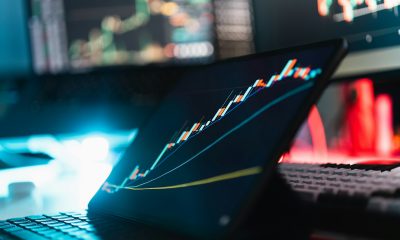Featured
What can be gleaned from the Lehman Brother’s free fall?
It’s been 10 years since the Lehman Brother’s stock made a free fall. Find out what the economy’s movers and shakers can learn from this event.

Global financial services firm Lehman Brother’s stock was in free fall during the first week of September 2008. After making huge bets in the mortgage securities space, Lehman’s President Dick Fuld feared bankruptcy and frantically sought out a buyer. The company was hoping to strike a weekend deal with either Barclays PLC or Bank of America.
Nevertheless, Lehman’s outsized investments in the mortgage market ultimately proved them too risky a partner for anyone; and the giant investment bank went belly-up on September 15. Prior to this event, Lehman had reported record earnings every year from 2005 to 2007. The Street believed the company to be infallible. Analysts held on to hope until the bitter end. Their mantra went something like this, “nothing to see here, this is a small correction in a small section of the housing market that has little effect on the overall economy.”
But it wasn’t the first time that year that analysts got it wrong. The Wall Street perma-bulls also missed the eleventh-hour fire sale of Bear Sterns to JP Morgan for $2 a share. Five days before the sale, a CNBC host who loves to play with buttons fervently advised a viewer to leave his money in the firm, insisting it would be silly to make a sale at current values. However, less than a week later, it lost $60 per share!
The Lehman case became the largest bankruptcy filing in history, surpassing other bankrupt giants such as WorldCom and Enron. Markets were panicked. The following day, September 16, AIG called then-Fed Chairman Ben Bernanke asking for an $85 billion bailout. For years, AIG had collected premiums on Credit Default Swaps (CDS), which are basically insurance policies on debt. All three credit rating agencies, which had rubber-stamped all new debt issuances as AAA for years, finally downgraded AIG to AA-, immediately triggering a collateral call of $32 billion. In just one day, AIG was basically insolvent. AIG had written CDS contracts on $500 billion in assets, $78 billion of these were on residential and commercial mortgages and home equity loans. Remember, the same types of loans Wall Street and the Fed assured investors were rock solid.
And this was Tuesday; the week had just begun…
September of 2008 was perhaps the most eventful month in Wall Street’s history. On September 21, Goldman Sachs and Morgan Stanley, the last two independent investment banks, become bank holding companies, so they could compete for deposits with commercial banks and better ensure their solvency.
On September 25, a group of Washington Mutual Bank executives boarded a plane to Seattle. Upon de-boarded, they discovered that the Fed had seized their bank assets and sold them to JPMorgan Chase; marking it the biggest U.S. bank failure in history.
And then, of course, Congress got in on the fun rejecting a $700 billion Wall Street financial rescue package known as the Troubled Asset Relief Program, or TARP, on September 29, before accepting it on October 3.
Also occurring in that infamous month of September 2008 was the placing into conservatorship of both Fannie Mae and Freddie Mac; those two giant government-sponsored enterprises that would have gone bankrupt without a taxpayer bailout.

All was not smooth-sailing for Wall Street in September 2008. (Photo by EllenTheMelon1 via Flickr. CC BY-SA 2.0.)
The problems didn’t end with September. October saw Wells Fargo, the biggest U.S. bank on the West Coast, squeeze out Citi Group to buy floundering Wachovia for about $14.8 billion. And it was a good thing Citi wasn’t successful in their acquisition because in November, the Treasury Department, Federal Reserve, and Federal Deposit Insurance Corp., all had to come up with a plan to rescue Citigroup. Citi issued preferred shares to the Treasury and FDIC in exchange for protection against losses on $306 billion of securities it held.
When the dust settled, the government exited the mergers and acquisitions business and did what it does best—namely, create a scheme to monetize debt and re-inflate asset prices. The first round of Quantitative Easing—a form of government-sponsored counterfeiting—was announced on November 25, 2008.
It’s important to remember that while this major crisis was brewing, the Fed saw nothing on the horizon. Then Fed Chair Ben Bernanke saw no bubbles or risk for the broader economy, even as subprime mortgages started to collapse. Janet Yellen, Bernanke’s successor as Fed Chair, made this infamous quote regarding the real estate sector in September 2006, “Of course, housing is a relatively small sector of the economy, and its decline should be self-correcting.”
Fast forward to today, Wall Street and the Fed are busy assuring us there are no bubbles out there at all. And, even if one does exist, it poses no threat to the overall economy whatsoever. They want you to ignore the doubling of the national debt since Lehman failed. Don’t worry about an annual deficit of $1 trillion either, which is projected to only surge “big league” from its current level of over 5 percent of GDP. Never mind stock prices that are 1.5 times the underlying economy—a valuation so high that it has never been witnessed before. A doubling of corporate debt to a record 45 percent of GDP isn’t a concern either—even when considering the quality of that debt is at a record low. And, having trillions of dollars worth of sovereign debt with a negative yield is just par for the course…or so they insist.
At least that is their public spin. However, the Fed recently found it necessary to telegraph to certain insiders within the Main Stream Financial Media what it would do during the next financial crisis. Here is the plan: It has pledged to act early and forcefully once the next crisis manifests. The Fed will also publicly promise to do whatever it takes to fight deflation and tumbling asset prices and rising unemployment rates immediately—there will be no scaling into the next fight. Finally, our government will not delay or tinker around the edges when it comes to passing the next fiscal stimulus. It seems both parties have agreed that a massive tax cutting and infrastructure package would need to be enacted very quickly once the next recession arrives.
Of course, our government will have to recognize a crisis exists in the first place, which given the historical record, won’t be until the markets are in absolute free fall. But assuming they do eventually arrive on the scene, those are the things it would try to do “better.” This is crucial to understand if you want to make the most prudent investment decisions going forward. This is because the changes to economic growth and with the inflation/deflation dynamic are going to be unprecedented in scope and in magnitude. If investors are not modeling those changes, they will be blindsided. Prepare now while you still have a chance!
(Featured image by Johannes Geiger via Wikimedia Commons. CC BY-SA 3.0.)
—
DISCLAIMER: This article expresses my own ideas and opinions. Any information I have shared are from sources that I believe to be reliable and accurate. I did not receive any financial compensation for writing this post, nor do I own any shares in any company I’ve mentioned. I encourage any reader to do their own diligent research first before making any investment decisions.

-

 Impact Investing4 hours ago
Impact Investing4 hours agoBeyond the ESG Label: Integrating Sustainability for Long-Term Value
-

 Business2 weeks ago
Business2 weeks agoTopRanked.io Weekly Affiliate Digest: What’s Hot in Affiliate Marketing [1xBet + FIFA World Cup]
-

 Crypto1 week ago
Crypto1 week agoBitMine Surpasses 4 Million ETH Holdings Amid Market Volatility
-

 Biotech4 hours ago
Biotech4 hours agoMedical Research in 2025: A Turning Point for Precision and Personalized Medicine
























You must be logged in to post a comment Login